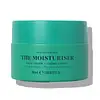What's inside
What's inside
 Key Ingredients
Key Ingredients

 Benefits
Benefits

 Concerns
Concerns

 Ingredients Side-by-side
Ingredients Side-by-side

Water
Skin ConditioningDimethicone
EmollientGlycerin
HumectantNylon-12
Steareth-21
CleansingDipropylene Glycol
HumectantAlcohol Denat.
AntimicrobialBoron Nitride
AbsorbentAmmonium Acryloyldimethyltaurate/Vp Copolymer
Helianthus Annuus Seed Oil
EmollientPhenoxyethanol
PreservativeVitis Vinifera Seed Oil
EmollientTocopherol
AntioxidantBis-PEG/PPG-20/20 Dimethicone
EmollientSesamum Indicum Seed Oil
EmollientGlycine Soja Oil
EmollientCaprylyl Glycol
EmollientPropylene Glycol
HumectantPolyacrylamide
Dimethiconol
EmollientSodium Benzoate
MaskingC13-14 Isoparaffin
EmollientDimethicone/Vinyl Dimethicone Crosspolymer
Skin ConditioningPentaerythrityl Tetra-Di-T-Butyl Hydroxyhydrocinnamate
AntioxidantSilybum Marianum Extract
Skin ConditioningLaureth-7
EmulsifyingBiosaccharide Gum-1
HumectantGlycine Soja Protein
EmulsifyingCucumis Sativus Fruit Extract
EmollientCananga Odorata Flower Oil
MaskingAnthemis Nobilis Flower Oil
MaskingLinalool
PerfumingPelargonium Graveolens Flower Oil
MaskingWater, Dimethicone, Glycerin, Nylon-12, Steareth-21, Dipropylene Glycol, Alcohol Denat., Boron Nitride, Ammonium Acryloyldimethyltaurate/Vp Copolymer, Helianthus Annuus Seed Oil, Phenoxyethanol, Vitis Vinifera Seed Oil, Tocopherol, Bis-PEG/PPG-20/20 Dimethicone, Sesamum Indicum Seed Oil, Glycine Soja Oil, Caprylyl Glycol, Propylene Glycol, Polyacrylamide, Dimethiconol, Sodium Benzoate, C13-14 Isoparaffin, Dimethicone/Vinyl Dimethicone Crosspolymer, Pentaerythrityl Tetra-Di-T-Butyl Hydroxyhydrocinnamate, Silybum Marianum Extract, Laureth-7, Biosaccharide Gum-1, Glycine Soja Protein, Cucumis Sativus Fruit Extract, Cananga Odorata Flower Oil, Anthemis Nobilis Flower Oil, Linalool, Pelargonium Graveolens Flower Oil
Water
Skin ConditioningPropanediol
SolventPolyglyceryl-3 Cetearyl Ether Olivate
EmulsifyingGlycerin
HumectantCanola Oil
EmollientCetearyl Alcohol
EmollientSqualane
EmollientJojoba Oil/Macadamia Seed Oil Esters
Skin ConditioningCaprylic/Capric Triglyceride
MaskingDimethicone
EmollientOctyldodecanol
EmollientFructooligosaccharides
HumectantOctyldodecyl PCA
EmollientBeta Vulgaris Root Extract
Skin ConditioningTerminalia Ferdinandiana Fruit Extract
AntioxidantPodocarpus Elatus Fruit Extract
Skin ConditioningPleiogynium Timoriense Fruit Extract
Skin ConditioningPhenoxyethanol
PreservativeCarbomer
Emulsion StabilisingSqualene
EmollientHydroxyacetophenone
Antioxidant7-Dehydrocholesterol
Emulsion StabilisingParfum
MaskingPotassium Lactate
BufferingSodium Gluconate
Skin ConditioningDimethicone/Vinyl Dimethicone Crosspolymer
Skin ConditioningEthylparaben
PreservativeMethylparaben
PreservativeSodium Hydroxide
BufferingButylene Glycol
HumectantLactic Acid
BufferingPhytosteryl Macadamiate
Skin ConditioningTocopherol
AntioxidantSodium Hyaluronate
Humectant1,2-Hexanediol
Skin ConditioningCeramide NP
Skin ConditioningPhytosterols
Skin ConditioningWater, Propanediol, Polyglyceryl-3 Cetearyl Ether Olivate, Glycerin, Canola Oil, Cetearyl Alcohol, Squalane, Jojoba Oil/Macadamia Seed Oil Esters, Caprylic/Capric Triglyceride, Dimethicone, Octyldodecanol, Fructooligosaccharides, Octyldodecyl PCA, Beta Vulgaris Root Extract, Terminalia Ferdinandiana Fruit Extract, Podocarpus Elatus Fruit Extract, Pleiogynium Timoriense Fruit Extract, Phenoxyethanol, Carbomer, Squalene, Hydroxyacetophenone, 7-Dehydrocholesterol, Parfum, Potassium Lactate, Sodium Gluconate, Dimethicone/Vinyl Dimethicone Crosspolymer, Ethylparaben, Methylparaben, Sodium Hydroxide, Butylene Glycol, Lactic Acid, Phytosteryl Macadamiate, Tocopherol, Sodium Hyaluronate, 1,2-Hexanediol, Ceramide NP, Phytosterols
Ingredients Explained
These ingredients are found in both products.
Ingredients higher up in an ingredient list are typically present in a larger amount.
Dimethicone is a type of synthetic silicone created from natural materials such as quartz.
What it does:
Dimethicone comes in different viscosities:
Depending on the viscosity, dimethicone has different properties.
Ingredients lists don't always show which type is used, so we recommend reaching out to the brand if you have questions about the viscosity.
This ingredient is unlikely to cause irritation because it does not get absorbed into skin. However, people with silicone allergies should be careful about using this ingredient.
Note: Dimethicone may contribute to pilling. This is because it is not oil or water soluble, so pilling may occur when layered with products. When mixed with heavy oils in a formula, the outcome is also quite greasy.
Learn more about DimethiconeThis ingredient is a silicone used to improve the texture of products and absorb oil. It does not get absorbed into the skin.
Like other silicones, Dimethicone/Vinyl Dimethicone Crosspolymer helps condition the skin by creating a barrier. In this sense, it can act as an emollient and trap moisture in.
This ingredient is a type of elastomer.
Learn more about Dimethicone/Vinyl Dimethicone CrosspolymerGlycerin is already naturally found in your skin. It helps moisturize and protect your skin.
A study from 2016 found glycerin to be more effective as a humectant than AHAs and hyaluronic acid.
As a humectant, it helps the skin stay hydrated by pulling moisture to your skin. The low molecular weight of glycerin allows it to pull moisture into the deeper layers of your skin.
Hydrated skin improves your skin barrier; Your skin barrier helps protect against irritants and bacteria.
Glycerin has also been found to have antimicrobial and antiviral properties. Due to these properties, glycerin is often used in wound and burn treatments.
In cosmetics, glycerin is usually derived from plants such as soybean or palm. However, it can also be sourced from animals, such as tallow or animal fat.
This ingredient is organic, colorless, odorless, and non-toxic.
Glycerin is the name for this ingredient in American English. British English uses Glycerol/Glycerine.
Learn more about GlycerinPhenoxyethanol is a preservative that has germicide, antimicrobial, and aromatic properties. Studies show that phenoxyethanol can prevent microbial growth. By itself, it has a scent that is similar to that of a rose.
It's often used in formulations along with Caprylyl Glycol to preserve the shelf life of products.
Tocopherol (also known as Vitamin E) is a common antioxidant used to help protect the skin from free-radicals and strengthen the skin barrier. It's also fat soluble - this means our skin is great at absorbing it.
Vitamin E also helps keep your natural skin lipids healthy. Your lipid skin barrier naturally consists of lipids, ceramides, and fatty acids. Vitamin E offers extra protection for your skin’s lipid barrier, keeping your skin healthy and nourished.
Another benefit is a bit of UV protection. Vitamin E helps reduce the damage caused by UVB rays. (It should not replace your sunscreen). Combining it with Vitamin C can decrease sunburned cells and hyperpigmentation after UV exposure.
You might have noticed Vitamin E + C often paired together. This is because it is great at stabilizing Vitamin C. Using the two together helps increase the effectiveness of both ingredients.
There are often claims that Vitamin E can reduce/prevent scarring, but these claims haven't been confirmed by scientific research.
Learn more about TocopherolWater. It's the most common cosmetic ingredient of all. You'll usually see it at the top of ingredient lists, meaning that it makes up the largest part of the product.
So why is it so popular? Water most often acts as a solvent - this means that it helps dissolve other ingredients into the formulation.
You'll also recognize water as that liquid we all need to stay alive. If you see this, drink a glass of water. Stay hydrated!
Learn more about Water